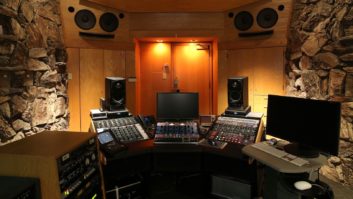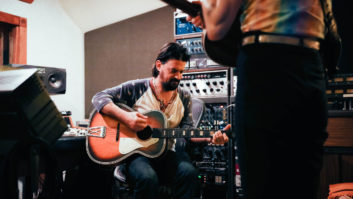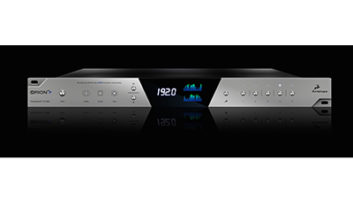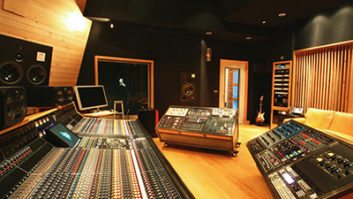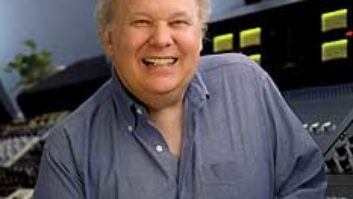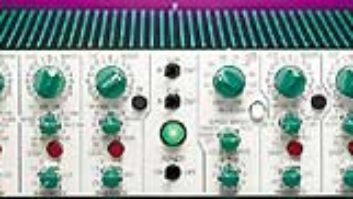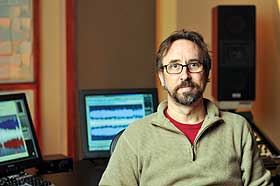
Yes Master Studios’ Jim DeMain
Periodically, we like to check in with folks in the world of mastering to see what’s happening in that end of the audio business and find out what’s on their minds. The good news? Even with the downturn in the economy and the falling fortunes of the major record labels, there still seems to be a high demand for that “finishing touch” that professional mastering gives to a project.
We recently spoke with four top mastering engineers about a range of issues. First meet our panel for this forum (which was assembled from separate interviews).
Jim DeMain owns and operates Yes Master Studios (Nashville), which has been serving large and small acts from the Music City region and clients all over the world for the past 12 years. Though Yes Master was badly damaged in the devastating Nashville flood in May 2010, DeMain has barely missed a beat, working steadily in a temporary space while his studio is being rebuilt.
Mike Wells of San Francisco’s Mike Wells Mastering is not just one of the Bay Area’s leading mastering engineers, he is also a vital member of the audio community in general—an educator who has run “Audio Outreach” seminars; a member of the Board of Governors of NARAS; and co-chair of the workshops at the recent San Francisco AES show, among other extracurricular activities.
A mastering engineer for three decades, Stephen Marcussen has run his state-of-the-art Marcussen Mastering in Hollywood for the past 10 years, and opened a shiny new facility just recently. Aside from tons of major-label and indie work, Marcussen Mastering also does copious 5.1 surround jobs.
Situated on the third floor of one of Manhattan’s busiest and most respected facilities—Avatar Studios—Kevorkian Mastering, named for engineer Fred Kevorkian, has been attracting a diverse range of clients for the past six years. Previously, Kevorkian worked at Sear Sound and Absolute Audio.
For a while there seemed to be an increase in the D.I.Y. aesthetic, where more people believed they could do a professional mastering job at home. Has that cut into your business and do you find yourself occasionally correcting/repairing poorly done mastering jobs?
DeMain: Maybe, but for some reason I’m still really busy. I wonder if it’s because there are more independent artists making CDs and EPs. So the percentage of people that want mastering has actually gone up even though the established record companies aren’t putting out as much product. It seems to me that there’s more indie work now than ever before.
Also, I think mastering still seems a little mysterious to a lot of people. Most of the guys who are really in the game have serious playback systems. And they also have a reputation. So I think there will always be a percentage of artists who, even if they make their own record, are open to the idea to have one last guy that’s a professional dot all the “i”s and make sure it’s all right.

Mike Wells of Mike Wells Mastering
Wells: I re-do projects all the time. It ranges from people saying, “I tried to do it myself and I couldn’t figure it out,” to, “My friend tried to do it and he couldn’t, so now we’re talking to you.” At the end of the day, most of it comes down to mastering engineers being able to communicate—especially to independent artists—what is achievable given the recording. Sometimes it’s a tough-love answer. I have found that it’s not a good idea to promise things that can’t be delivered. In the world of Internet mastering, we see that happening every day: Grand promises are made for a dollar a song.
I’m hoping that in the next few years we might see a renaissance in the appreciation for those who have dedicated themselves to audio engineering, whether it’s tracking, mixing or mastering. Over the last decade, the manufacturing and sales sector have really pushed with such fervor this idea that you can do everything yourself, but the reality is most people are going to fall short in one or all of those areas, no matter how diligent they are, and there is no plug-in that is going to make up the shortfall of what an actual professional in one of those areas can do for them.

Marcussen Mastering’s Stephen Marcussen
Kevorkian: I mostly see two types of mixes coming though the door: The “old-school” ones with plenty of headroom, and the mixes that have been already maxed out and been brick-wall-limited to death. I understand this [latter situation] was probably done to impress the label or the artist. Once in a while, I get those loud mixes and they sound amazing. There is nothing I could do to make them sound better. So I do the best possible transfer to the 16-bit/44.1kHz world. Those are isolated cases. Most of the time, over-limited mixes do need some work, and unfortunately when there are no more transients left in the program, it is very hard to do any corrections—de-essers don’t work the way they should and compressors are useless. Unless the mixing engineer is very confident with the processing he applies to the final mix, I would suggest providing the client with the pumped-up versions for approval and bring the non-processed files to the mastering session. It’s so much better to work with.
Marcussen: I’ve seen a lot of people go through the D.I.Y. stage; I think that’s part of growth in this business. If you’re lucky enough to be able to make a record and you’ve got a shoestring budget and that’s how you’ve got to do it, then that’s how you’ve got to do it. There are a lot of D.I.Y. guys who provide a valuable service, and it’s a stepping-stone for artists to get their stuff out. It’s not all bad—you can do some fairly impressive stuff in some of these workstations; we see it. But at the end of the day, when you go to mastering, you’re really paying for the guy’s experience that’s working on your project. Anybody can technically add bottom, middle, top, whatever it is—make it loud, make it this or that. But when you go to somebody that’s been doing it for a long time, there’s a whole different perception that comes with that and that’s obviously a good thing.
Years ago, when Pro Tools was really taking off, we started hearing a lot of complaints in the mastering community about receiving unlabeled PT sessions from acts, poorly employed DSP plug-ins, etc. Has that situation improved as musicians have gotten more savvy about using DAWs and plug-ins have, by most accounts, gotten better?
Kevorkian: This is why I don’t have Pro Tools! I don’t have that problem. I work mostly from stereo mixes—not from sessions. I understand why it could be productive to adjust a mix while mastering, but most of my clients don’t have the luxury to spend two or three hours on a song anyway. To be honest, I don’t even like working from stems. To me, it takes all the spontaneity away. I like to work fast and have the client evaluate the result in an environment they know well. They can then touch up their mixes if needed and I will recall my settings. Mixing is an art, and I am not a mixing engineer. Occasionally, I am happy to have a kick track stem available to add a little punch to a mix that needed help.
Today, almost every musician has a more or less elaborate studio setup at home. Like everyone else, they have to go through a learning curve. They are more knowledgeable about software and plug-ins, but still, talent makes the difference.

Fred Kevorkian of Kevorkian Mastering
Wells: I’m someone who works with a lot of independent artists, where the artist is also the engineer, but they’re not professional engineers: They have a DAW and maybe they’re recording in their practice space, they’ve read a lot of magazines and gone on the Internet to try and glean information that they can apply in their environment to get their project created. What I see missing from that equation right now is a real depth of understanding of the terminology. People throw around a lot of terms—“dither” is a good example—without understanding what “dither” does.
They know they need to do it, but are you talking about dither with or without noise shaping? Once they go beneath the surface, there isn’t much understanding. People have a lot more access to information now, but the deeper understanding is still at the very top level with professionals. I think it’s a reflection of the times because when you look at how many directions people are pulled today doing their work, their music, their social media—e-mail, text messaging and phone—there’s not a lot of time to dedicate oneself to really becoming proficient in something like audio engineering when you also need to be the musician and the manager and the promoter and whatnot.
Marcussen: We see everything imaginable—including, I’ve got to say, plenty of really fantastic, well-put-together projects that already sound great. But we also see things that come in already distorted for you. [Laughs] We see things that come in with a little pre-mastering “help” on them. You get the call: “Can you master from an MP3?” Well, technically, yes, you can, but do you want to is the question.
There are definitely times when there’s a problem that surfaces in the mastering room and then we have to go back to the client and see what they want to do. I would be remiss in my duty if I didn’t say, “Hey, these files look funny,” or, “This tape doesn’t have stable tones”; whatever the flaw is. The good news is that today most of this stuff is correctable.
DeMain: The percentage of unlabeled files is actually pretty small. We do stuff from all over the world now because the Internet has made it so easy. Someone sees your name on a CD they like and all of a sudden we have clients in Italy and Sweden and France and England, Australia, South America, Scandinavia. Files exchanged over the Internet are always labeled properly and pretty much always have an e-mail with all the info. But then you still get the odd disc in the mail that’s just a CD with the files on it and there are no titles or sequence and sometimes no phone number, et cetera. It does make you scratch your head sometimes.
On the other hand, I’m actually surprised at how many great-sounding mixes I get from places you would never expect—mixing in the box or maybe a little home studio. The level of mixing has gotten a lot better. But my big complaint is that many mixers still think they need to do some kind of mastering to the mixes before it gets to me. So a lot of times I get stuff that’s been over-compressed. Then you have to explain to the client, “Well, I can’t really get that sound because you’ve already stamped it in a sense with what you have done to it, so it’s going to be tricky to get some punch or openness anymore because you’ve already taken it all out.”
How often do clients bring in specific records they hope you can somehow “match,” and is that a good thing?
Marcussen: People come in with their benchmarks, and say, “I like the XYZ album. It always has made me feel good. I’d like my record to feel like that.” That’s often the case. Sometimes you can look at the picture from a mastering perspective: Is it a warm record? Is it a loud record? Is it a lo-fi record? Is it a super-hi-fi record? Is it aggressive? I’m trying to see what they’re hearing on that album and then try to apply what I know to their project.
DeMain: Sometimes I get clients who come in with two or three other records, and say, “I want my record to sound like this.” I don’t mind giving it a try, but I’m really not into that because every time I’ve done that in the past, I’ve ended up having to re-do it because it never comes out right to everybody’s satisfaction. I know “the customer is always right” and all that, but the reality is, you’re not that artist, you don’t have the same guys in your band, those aren’t the same songs, you didn’t record it at the same studio with the same engineer, and the same guy didn’t mix it through the same equipment. So if I can make your record sound like that with just a couple of EQs and compressors, I might as well be a miracle worker. My philosophy is, everything becomes what it’s going to be. In other words, I listen to it and I make it the best it can be for what it is. Obviously, I can push it in a direction—I can push some more bottom end into it to make it sound more rock, or a little more “top” for the country sound or whatever. But I find it really hard to copy other CDs.
Kevorkian: That doesn’t happen very often. Sometimes I wish they did, but most of the time I’m glad they don’t. Somehow, the sound of the reference records my clients bring to the session often has nothing to do with their mixes. I guess they have very high expectations. Unfortunately, we don’t have the ability to transform a mix; we can only enhance its quality and make it more compatible for the real world. A good-sounding record is not only the result of a good mastering job. The arrangements, the production, the recording and the mixing are all key elements. If the magic is not there in the flat mix, it won’t happen after the mastering session. At that point, you have to be very diplomatic and explain to the client what can or cannot be done to achieve their goal. You have to lay out the limitations of the process. But even if the reference source is way off, I can still pick up what the artist is aiming for—loudness, brightness, warmth, dynamics, et cetera—and I will do my best to make my client happy.
Wells: I encourage people to bring a reference because, especially with independent artists, they’re usually using one or two records to benchmark their mixes against, and that also represents partially what they’re hoping to achieve in mastering. It gives me a ton of information when I hear their mix and what they’re using as a reference for what they’re trying to achieve, so we can get to the common language faster that way.
What they’re going for will often come across more quickly and more easily by listening to something, rather than talking about high end, low end, warmth, air, sizzle, fairy dust—all these terms that are really personal.
Are there any pieces of gear you’re particularly hot on at the moment?
DeMain: The coolest thing I’ve gotten recently is actually an upgrade to something I’ve had for a while. It’s a digital compressor made by Weiss. I had the DS-1, which is a really nice box, but it was sort of the first one out of the chute, so I upgraded to the DS-1 MK3, which does all this new stuff I never could do before with that type of compressor.
My favorite overall piece of gear is still my monitoring system. I have Lipinski [707] speakers and a Carl Tatz PhantomFocus System, and I don’t know if I could do what I do without that because I can hear everything so well.
Wells: My Dangerous Music mastering console is the coolest piece of gear I own. Period. Additionally, I can’t say enough about my Dunlavy [SC-V] speakers. The detail, clarity and, most importantly, the lack of coloration is amazing on these speakers. They are as flat and as truthful as it gets.
Marcussen: We’re always adding things. Our move into the new place is a three-year project, and we were very fortunate that we were doing this just as Cat-6A—the latest 10-Meg cable—came out. In the new studio we can move data around so much more easily and our rooms are tied together better. Whatever comes down the road, we’ll be ready.
Kevorkian: I haven’t bought any major new piece of equipment in a few years. The last thing I got was a pair of Chandler LTD2 compressors—mastering versions—that complement very nicely my Manley Vari-Mu, which also has step controls for mastering applications.
But I’ve basically worked with the same setup for the past 10 years. After all, recording and mixing engineers still rely on 40-year-old pieces of equipment to get the result they’re looking for. I own all the analog and digital outboard gear I really need. They are still very musical by today’s standards. Too many options are not always a good thing for me. I’d rather know a handful of pieces of gear inside out. Just like knowing my room and my monitoring system. It’s critical.
